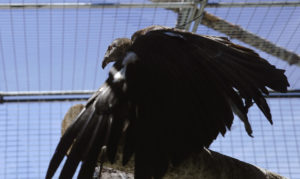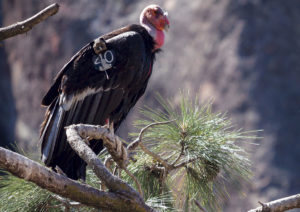For 13 years, Joe Burnett has led the Ventana Wildlife Society’s condor restoration efforts in Central California. On June 21, 2008, he–and the condors–faced a major wildfire for the first time. The Basin Complex Fire in the mountains near Big Sur burned out the pens where the group was holding eight condors being prepared for release. Burnett and his colleagues had to helicopter in behind the fire line to rescue them. The birds survived, though two wild condors did perish in the fire. Today, 50 wild birds fly in the areas around Big Sur and the Pinnacles National Monument.
BN: How did you and the birds react to the fire?
JB: This was the first fire for our condor flock as well as for me. I feel like we’re all a little more knowledgeable now because of it. For the older birds, it’s really important for them to pass that knowledge on. We did lose two birds. At that point, we had 20-plus birds in the fire area, and to have lost only two means this fire was gentle on us.
BN: You had one adult mentor bird and seven juveniles in the pens. How did you save them?
JB: By 2 p.m. on June 21st, the fire had raced up the ridge and cut off our road access. These birds had never flown in the wild. If we had just let them go, they’d almost surely have died. The next day was our last chance to get them out, and we still had no leads on a helicopter. Finally the Coast Guard got clearance to help us. I’ll never forget telling [VWS staffers] Mike and Henry, “We’re going to helicopter in behind the fire and get those birds.” They got quiet, but then they both smiled and said, “Let’s go.”
It was like being in a movie while it was happening. We only had so much time till dark, when we had to fly out. They picked us up at 4 p.m. in Monterey but they didn’t drop us off on the ridge till 5:30. We had to run three miles from the helicopter to the pens, and it was as still and eerie as you can imagine right before a fire. Not the sound of a bird or anything. Your brain is telling you, “What are you doing?”
It takes all three of us to kennel a condor. We have to capture each bird and put them into those extra-large animal kennels, the ones used for large dogs. We got the first bird kenneled up at around six. We got two kennels onto an ATV, and it was barely safe enough that way. You had to drive standing up, going up this winding dirt road back to the helipad as fast as you could. By the last trip, it was down to the wire. Mike and Henry were covered in sweat, and they just couldn’t get the last bird. She was really strong and crafty. We thought for a minute we’d have to leave her, but, from the top of a ladder, I just managed to grab her from the highest branch in the pen. That bird was 438 and she was actually released into the wild a few months ago.
BN: How did the wild birds respond to the fire?
JB: We saw the birds head for cover along the coast, to the marine layer. But condors can’t fly at night. They’re so big that they depend on thermals, and there are no thermals at night. They can make a short hop to another tree, but no more than that. We’re pretty sure that’s how we lost the two birds in the fire–they picked the wrong spot to roost at night.
BN: You recently had to retrieve a chick that had died from eating trash. Why did the adult birds bring trash to feed their chick?
JB: They’re hardwired to find bone chips and even shells as a calcium source for the chicks. Nowadays there are sources of artificial debris in the environment. Broken or old PVC that shatters is a serious hazard. Once we pulled 40 razor-sharp pieces out of a nest. We call it microtrash–shards of glass, bottle caps, coins, and other garbage they find along the coast on the highway pullouts.
Here we are, worried about fires, but there are these other ongoing, indirect threats. Not as dramatic as a fire but frustrating to us. We pull off this rescue from the fire, and then you have something like this that just blindsides you. And it’s as much of an impact. The loss of a condor is the loss of a condor.
BN: After so many years with the birds, that must hit you pretty hard.
JB: Condors are so long-lived. Andean condors, close cousins of our California condors, live 70 to 80 years in the wild. And I have known all these birds since they were young chicks. I have a weird attachment to all of them. I can’t describe it. These 12-year-old birds, the elders in our flock, are probably going to outlive me. It’s very humbling.
Learn more about condors at ventanaws.org.

.jpg)



